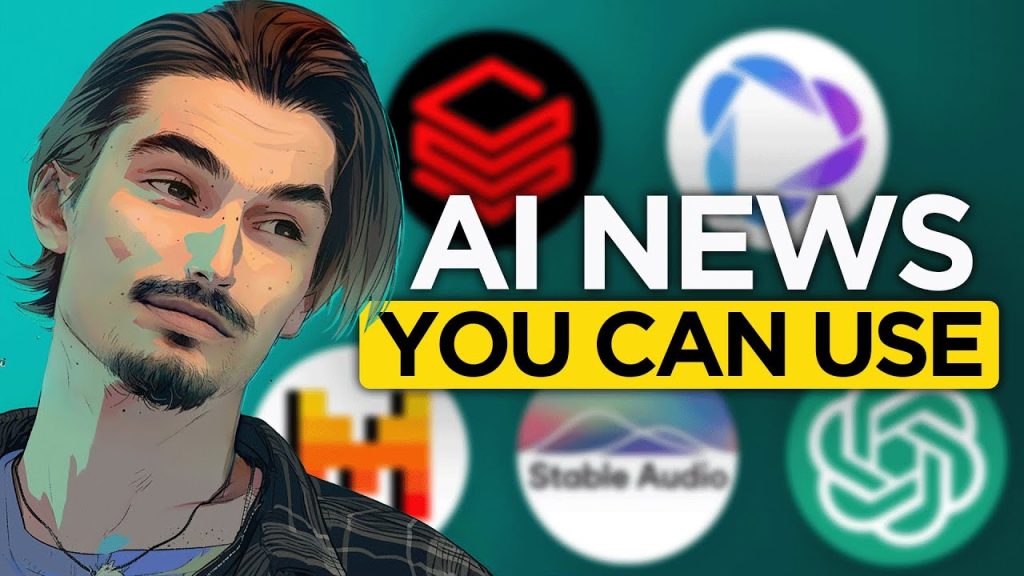Exciting New Developments in the AI World

The world of AI is buzzing with new features and capabilities that promise to make our lives easier and more fun. From image editing to music generation, the latest advancements are nothing short of revolutionary. In this overview, we delve into the most exciting updates and innovations, giving you a snapshot of what’s happening in the AI sphere.
Chat GPT has rolled out some incredible new features, and Stability AI’s Stable Audio 2 is now freely available. Additionally, new open-source models are pushing the boundaries of what’s possible, while studies reveal the limitations of AI detectors. Plus, we’ll take a look at some unique applications and fun tools that are sure to capture your imagination. So, let’s dive right in and explore these groundbreaking developments.
Chat GPT enhancements
The latest update from Chat GPT introduces a new, highly impactful feature. Users can now perform inpainting, allowing them to selectively edit parts of an image without altering the entire image. For example, users can change the color of an alpaca’s eyes to blue by simply selecting the eyes and instructing the model. This feature, previously available in other tools, simplifies image editing for users who may not be proficient with software like Photoshop.
In addition, Chat GPT can now be accessed without logging in. Although this feature is not yet available in Europe, U.S. users can visit chat.open.com and start using GPT 3.5 for free. This makes it easier for new users to try the tool without going through the hassle of creating an account.
Stable Audio 2 Released
Stability AI has made its Stable Audio 2 completely free. This tool generates music without lyrics, making it ideal for background music. Users can create tracks up to three minutes long and have 20 tracks available after a quick Google login. The tracks are commercially usable as they are built on a licensed dataset.
Moreover, Stable Audio 2 isn’t just text-to-audio; it also supports audio-to-audio conversions. Users can record a sound, and the tool will transform it into music. This feature provides a fun and accessible way for users to create music, even with minimal musical knowledge.
Open Source Models
A new open-source model, Databricks’ dbrx, has been released. Although not fully open-source due to its unique license, it performs impressively on popular benchmarks. It outperforms other models in programming and math while being more efficient to train and faster in inference. Users can try it out on Hugging Face.
Another open-source model, Mistal 2.8 Dolphin, is fully uncensored and capable of answering any question. Although it’s not easy to run locally, it offers a new level of interaction for those interested in uncensored models.
AI Detectors: Limitations Revealed
A new study has shown that AI detectors are not reliable. These detectors often struggle to correctly identify text generated by AI, especially when simple techniques are used to fool them. The study also found that non-native English speakers are often misidentified as using AI.
This is significant because it highlights the limitations of current AI detection tools. OpenAI had previously withdrawn their AI detection software due to its unreliability. This emphasizes the need for alternative methods to identify AI-generated text.
Users should be aware that AI detectors can be easily fooled with minor adjustments to the text. This casts doubt on their effectiveness and suggests that relying solely on these tools is not advisable.
Renaming Images with AI
A new app for Windows uses GPT Vision to rename images based on their content. Originally available for Mac, this app costs $25 and requires an API key for renaming. It’s a handy tool for organizing messy hard drives filled with unnamed pictures.
AI Avatars in Motion
Hen has released a new feature for its AI avatars, allowing them to move while speaking. Users can try this feature by submitting a phrase and receiving a video via email. This technology makes the avatars more lifelike and engaging.
The potential applications for these advanced avatars are vast, from social media content to business presentations. As the technology improves, we can expect even more realistic and versatile avatars.
This feature sets Hen apart as a leader in the AI avatar space. The company continues to innovate, providing users with cutting-edge tools for digital communication.
Unique AI Benchmarks
Evaluating AI models is becoming increasingly challenging. A new GitHub repository, LLM Coliseum, introduces a unique benchmark where AI models play Street Fighter turn by turn. This creative approach provides a fresh way to assess model performance.
Traditional benchmarks often fail to reflect real-world use cases. The LLM Coliseum’s novel method encourages innovative thinking in how we measure AI capabilities. Although unconventional, it’s an intriguing concept that could influence future benchmarking standards.
From game-changing updates in Chat GPT to revolutionary new features in AI music generation, this week’s advancements illustrate just how rapidly the AI landscape is evolving. The emergence of stable and open-source models only further democratizes AI technology, making it more accessible to users who may not have technical backgrounds. Conversely, the limitations of AI detectors remind us that while AI is advancing, it is not without its flaws. These innovations, combined with unique uses like AI avatars and creative benchmarking, indicate that the future of AI will be both exciting and complex. As we continue to integrate these tools into our daily lives, staying informed about these developments will be crucial.





